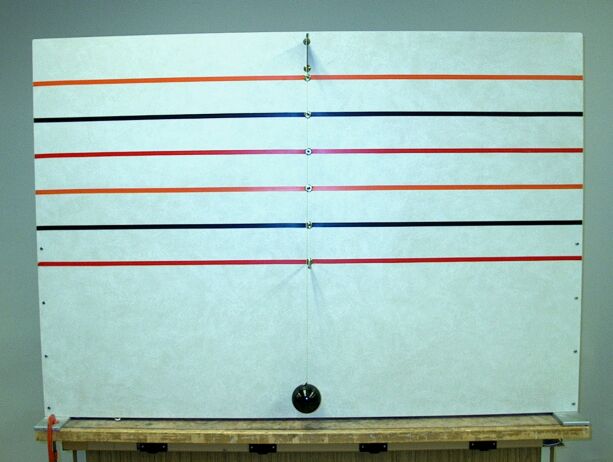

A video of this demonstration is available at this link.
A threaded insert at the center of each of the colored horizontal lines on this board, allows you to fasten a pin there. Thus, when you raise the pendulum bob and release it, the pendulum string strikes the pin at the middle of its swing. The pendulum bob continues its swing, with the pivot now where the pin is. No matter at which line you place the pin, from whichever line you release the pendulum bob, it rises on the opposite side to the same line. (As long as the length of string below the pin is enough to reach the line on the other side.)
When you set a pendulum oscillating (by raising the pendulum bob and then releasing it), the pendulum bob starts with gravitational potential energy equal to mgh, where m is the mass of the bob, g is the acceleration of gravity, and h is the height, relative to the bottom of the pendulum swing, of the point from which you release the bob. As the pendulum swings downward, gravity converts this potential energy into kinetic energy, so that at the bottom of the swing, the pendulum bob has zero potential energy, and its kinetic energy, (1/2)mv2, equals the inital potential energy (mgh). (So the velocity, v, equals √(2gh).) As the pendulum bob continues its swing past the bottom, its kinetic energy now decreases from this maximum value, until gravity has converted it entirely back to potential energy. By this point, absent friction, the bob has risen to the same height, on the opposite side of the swing, from which it was released, and its potential energy is again mgh, and its kinetic energy is again zero.
With the pendulum in this demonstration, you set a pin to stop the string when the pendulum is in the middle of its swing. You have a choice of five heights below the pivot, at which to set the pin. From whatever line you release the pendulum bob, it begins its swing with potential energy that corresponds to the height of that line above the bottom of the pendulum swing. At the bottom of the swing, the pendulum bob has kinetic energy equal to its original potential energy, so that no matter where you place the pin, and thus no matter where the new pivot point is, the pendulum bob must rise up on the other side until gravity has converted all of its kinetic energy back to potential energy (mgh). Thus, the bob must rise to the same line from which you released it.